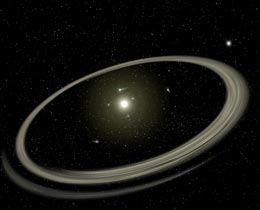
This artist's concept illustrates dust rings arising from massive collisions between large rocky bodies. A young, type-A star is shown circled by full-size planets and rings of dust beyond. These debris rings arise when embryonic planets smash into one another. See video animation of rings forming from collisions.
Courtesy NASA / JPL-Caltech / T. Pyle.
Astronomers using the infrared Spitzer Space Telescope have found dozens of debris disks stemming from recent collisions of solid bodies orbiting young — and not-so-young — stars. Some of the debris seems to come from very large individual collisions, such as the one that smashed the early Earth and created our Moon. Such evidence "reassures us that the probability is high" that terrestrial planets are abundant in the universe, Scott Kenyon (Harvard-Smithsonian Center of Astrophysics) said at a press conference Monday.
A dusty debris disk arises after an infant star's original, gassy protoplanetary disk has dissipated and left solid planetesimals behind to jostle and bang into one another. The IRAS satellite found the first signs of debris disks some 20 years ago around a few bright stars such as Vega, Fomalhaut, and Beta Pictoris. Now George H. Rieke (Steward Observatory) and 11 colleagues have used Spitzer to examine 266 stars having masses of 2 to 3 Suns and ages ranging from 5 million to 850 million years. They found dust from collisions forming "an immense variety" of debris disks around 71 of the stars.

When asteroids or planetesimals collide at speeds of a few kilometers per second, the kinetic energy creates a fireball and large amounts of dust. See video animation.
Courtesy NASA / JPL-Caltech / T. Pyle (SSC-Caltech).
Fine dust is the most visible part of a debris disk, but it doesn't last. Radiation pressure from the central star will clear it out in a matter of centuries to thousands of years. Finding fresh dust around stars that are hundreds of millions of years old means that collisions must be continuing now, long after the main planet-forming process is over. This situation is reminiscent of the early solar system's era of heavy bombardment, which cratered the Moon and other bodies intensely for about 650 million years after the solar system's birth.
Longtime circumstellar-disk researcher Anneila Sargent (Caltech), who has done similar studies using poorer data, calls Rieke's paper (which will appear in the Astrophysical Journal) "a beautiful piece of work, a real milestone." However, she still considers the evidence for individual very large collisions to be "speculative."

Planetary debris disks around nearby stars range from prominent to undetectable. Disk brightness or size as measured by Spitzer (vertical axis) is plotted against the age of the star (horizontal axis). Huge amounts of debris can accompany stars up to a few hundred million years old, though there is a trend toward less with age. But even around some of the youngest stars there is no detectable debris — indicating a wide variety of planetary-system properties from star to star.
Graph courtesy NASA / JPL-Caltech / G. Rieke.
 0
0
Comments
You must be logged in to post a comment.